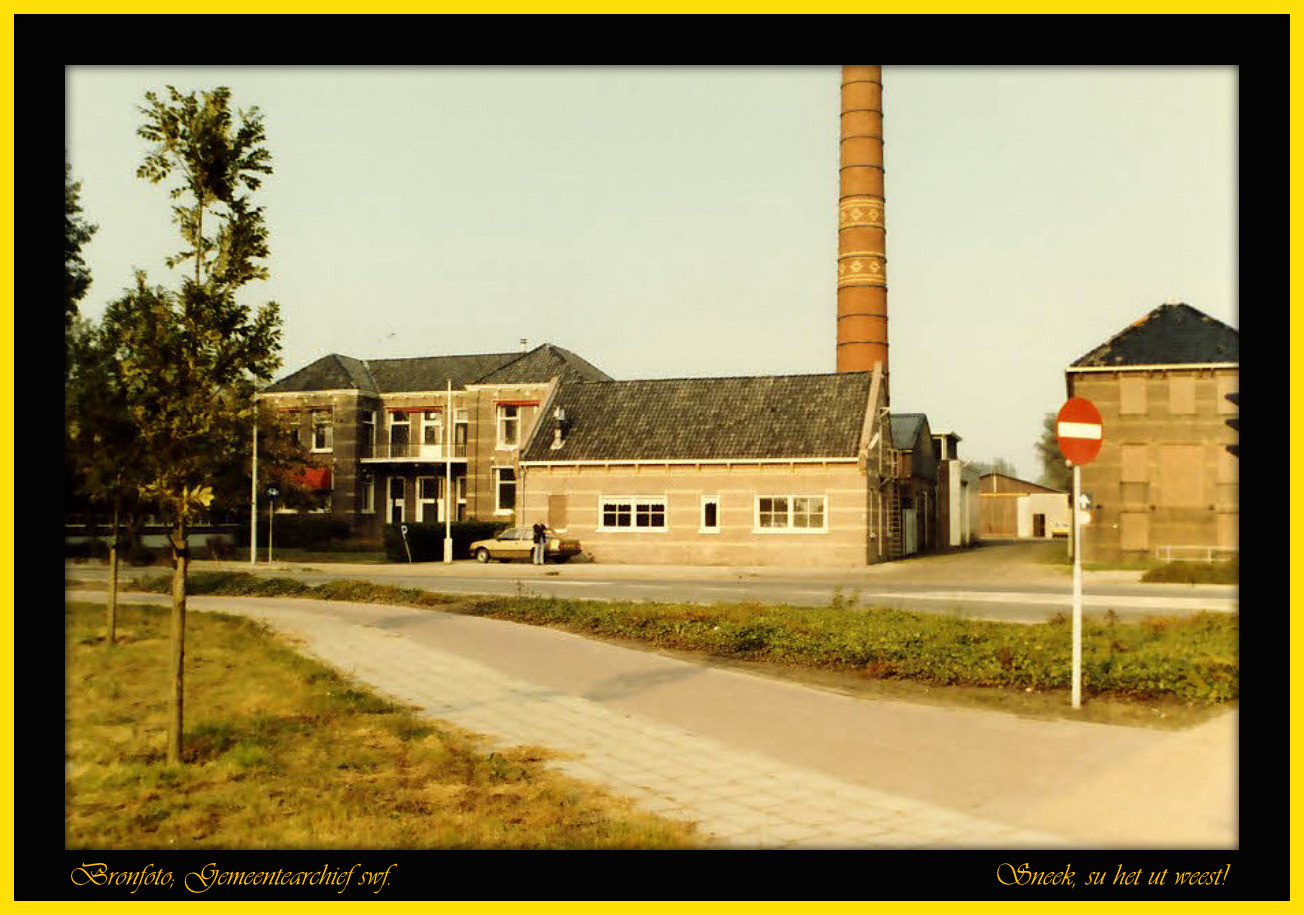
SSHUW Dairy KNM The Harste
The KNM dairy on the Harste
This was the first dairy built in 1882 in Ysbrechtum in the municipality of Wymbritseradeel and the last to close in Sneek in 1975. That the factory "moved" from Wymbritseradeel to Sneek had to do with the municipal redivision and border corrections. The factory disappeared in 1986. After the demolition in Patrimonium housing foundation settled here in a new office building. The warehouse behind the factory has long been used as a place of employment, storage and garage of a number of milk farmers in Sneek. The former office is still there and stands on the corner of Dr. Boumaweg and Willemstraat against the "stuufmeelkerkje". It now houses a real estate agent.
The other factory Normandia on Leeuwarderweg had closed earlier, established in 1888 - demolished in 1986.
The Harste
Where the Patyna, Ielanen branch is now located, formerly stood the home of Mayor S. M. van Haersma Buma of Wymbritseradeel. At the beginning of World War II, Buma was one of the first mayors in the Netherlands who made it clear that he did not agree with the policy of the Germans. He openly resisted and was eventually arrested by the German rulers. He was taken to The "Oranjehotel" in Scheveningen and via a number of concentration camps ended up in Neuengamme where he died on December 11, 1942 due to illness and increasing weakness. His son Bernardus van Haersma Buma became mayor of Workum and later Sneek in the 1970s. The grandson Sybrand van Haersma Buma was active in Hague circles as a list leader of the CDA and currently mayor of Leeuwarden. The house burned down in 1972 after several years of vacancy. In the 1980s, the nursing home De Ielanen was built on this site.
KI Station
Next to the Ielanen, Donker Groentechniek is located since the 70's in the building which was built as KI station de Harste. In the years just before the 2nd World War artificial insemination of cattle was started all around our country. The aim was to reduce contagious mating infections. On this former K.I. station bulls were housed for years from which semen was collected by means of a "jump" on an artificial cow. This semen was frozen and introduced to the cow in question by the inseminators via "straw" after a phone call from a farmer with a cow in heat.
Artificial insemination
Artificial insemination (AI) in cows is not something of recent years. As early as 1935, semen was artificially inserted into dairy cows in Friesland. Today, almost all dairy cattle are artificially inseminated. In beef cattle and in the cows of small-scale and hobby cattle farmers, a bull sometimes still accompanies the herd, but even here artificial insemination has become more common than natural mating.
AI has the advantage that a cattle farmer does not have to keep a bull himself, which is simply not without dangers. It also transmits fewer infectious diseases than natural mating. In fact, infertility caused by cow SOAs is the main reason for the rise of AI in the last century. Furthermore, on balance, insemination is more economical than housing a bull yourself. Genetic influence and production advance also traditionally played a role. That role has become increasingly emphatic over the years.
AI also has disadvantages. Genetic biodiversity decreases and genetic disorders increase if the semen of top bulls in particular is widely distributed. Also, the emphasis on breeding toward better milk or meat production can lead to less attention to aspects such as disease resistance, strength of build or natural calving. However, modern breeding programs do take into account an inbreeding coefficient and also (in organic farming) more and more divergent breeds are crossed in to get stronger animals. Today, the semen to be inseminated comes from breeding bulls kept for that purpose at so-called AI stations. AI bulls do their work 2 to 5 times a week. To this end, young breeding bulls first learn to jump on each other and later on an artificial cow (also called dummy or phantom cow). Some bulls continue to prefer animals of their own sex to a dummy cow. In both cases, when the bull literally gets his feet off the floor, the so-called semen catcher rushes in, because that is when the bull discharges his semen. About five billion sperm are released at once. The semen is put into "straws" (hundreds of straws per ejaculation) and then frozen in liquid nitrogen. At a temperature of minus 196 degrees Celsius, the semen remains good for years.
When a drafty cow is at the peak of her fertility, the inseminator (or the cattle farmer herself, who must have taken a course to do so) can insert the semen into the uterus through the sheath. Contraction of the uterine wall and fallopian tube causes the sperm to reach the egg. The actual fertilization takes place in the fallopian tube. Not every artificial insemination succeeds; on average, one-third of cows must be reinseminated.